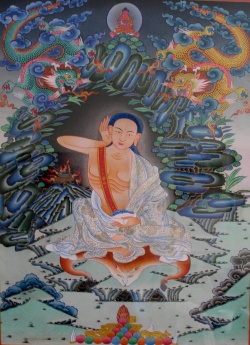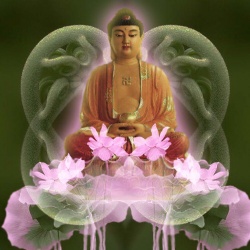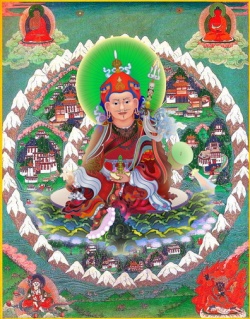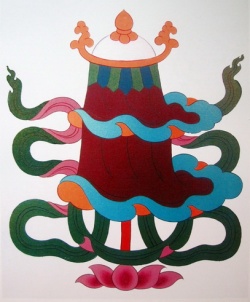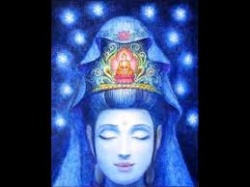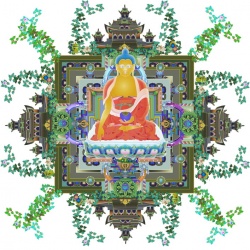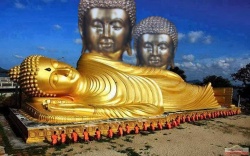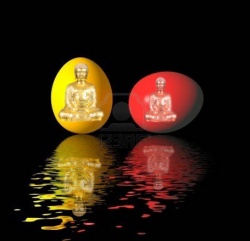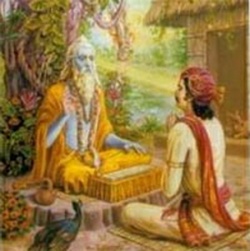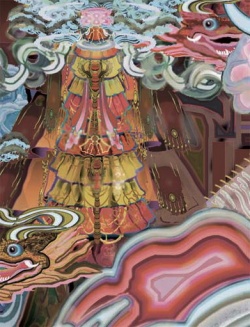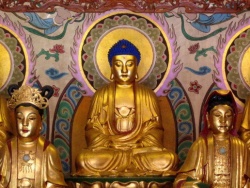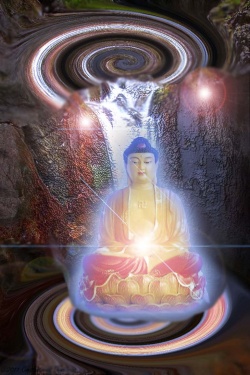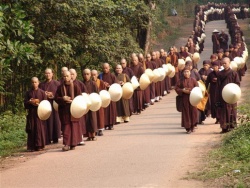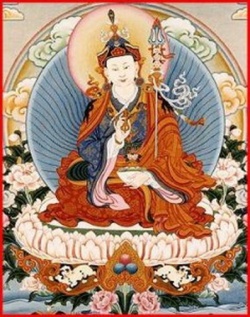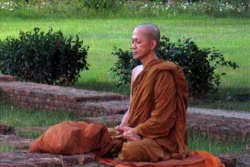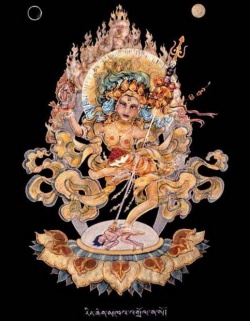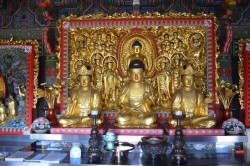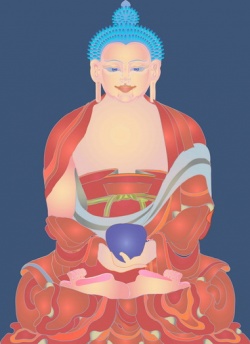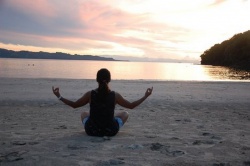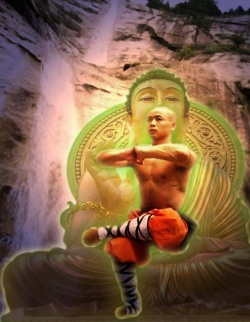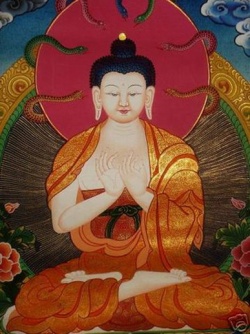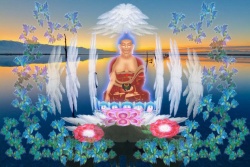Tantra as a Method for Spiritual Development
This evening I have been asked to speak about tantra as a method for spiritual development.
And this raises two questions: What is tantra? And what is spiritual development?
So if we look first at what does tantra mean, “tantra” has several meanings. One meaning is “a continuum,” because it comes from the Sanskrit verb root which means “to stretch,” so to go on and on and on.
And, by extension, another meaning of it is a loom for weaving, in which the strings are stretched from one side to another that you can then weave cloth or a rug on. So, as a continuum, the Tibetan tradition speaks of three levels of continuum.
And these are continuum's: they just go on and on and on. And so we have a basis level, what we all have naturally; and then a pathway level, which is tantra as a practice that’s going to lead to some goal; and then a resultant level, the goal that it can lead to.
So it’s on the foundation of this basis tantra that we practice path tantra to reach the goal: the resultant tantra.
Basis Level Tantra
So the basis level it’s referring to what we call in Buddhism our “Buddha-nature.” Now Buddha-nature is – we shouldn’t be misled by that translation of the term – it is referring to the factors that we all have.
It’s not just one nature, but it’s a whole group or network of different factors and characteristics that are part of the mental continuum.
We have a [[mental continuum}} that goes on from lifetime to lifetime, and these are the basic innate characteristics of it.
So the ability to know things, the ability to make appearances of things, the ability to communicate.
There’s energy associated with it, and there’s a basic warmth of mind – to take care of something, either our-self or others. And its most fundamental nature is that it doesn’t exist in some impossible way: some static thing that doesn’t do anything, separate from everything else.
So it’s on the basis of all these qualities, this continuum – of our mental continuum that has all these qualities – that we are able to develop ourselves; develop these qualities. And there are two explanations or two approaches to this.
One is that all those qualities are there in full on the basis level, but now they are obscured so they’re not functioning fully. Or the other explanation is that they’re there in terms of potentials and that they need to be developed.
So this is something which is very encouraging to understand – that we have all these potentials, we have all these abilities – but we shouldn’t fool ourselves into thinking that we are already a Buddha.
But, if we just speak in general, we can say that all these good qualities are the basis for us to develop ourselves.
Because I have the ability to understand things, I can understand more and more and more. And because there is basic warmth of the heart – you know, that certain sense to take care of something, either me or others – that can be developed into love and trying to take care of everybody equally.
So that’s the basis tantra, this basis continuum, which has no beginning and no end from the Buddhist point of view: lifetime to lifetime.
Path Level Tantra
Now when we talk about a path tantra, we are talking about a type of practice which will help us to either realize all our potentials or get rid of all the obscurations that are preventing these qualities from functioning.
And, in fact, both approaches are pretty much doing the same thing; it’s just a matter of how you conceptualize it.
Because, regardless of which approach we follow, we need to build up the potentials and get rid of the obstacles that are preventing our qualities from functioning fully. So it’s a matter of which one we are focusing on in the practice, but the practice turns out to be the same.
And here we are talking about a type of practice that can go on forever because, remember, we have this idea, this connotation of a tantra – that it has no beginning and no end; it’s a continuum.
So what type of practice could fulfill that requirement that it has – you know, it’s everlasting? Now we’re not talking about our own individual practice. Our own individual practice, obviously, will go up and down. So we’re not sustaining it twenty-four hours a day, are we? So, instead, what we are talking about is a method that utilizes something that is everlasting. And this is the method of using what I translate as “Buddha-forms” or “Buddha-figures.”
“Buddha-forms” or “Buddha-figures.”
Now a Buddha-form, we’re not talking about a statue. Sometimes the word that I’m using could be misunderstood in that manner.
But the alternative way that many people translate it, and this word is used for it in both Sanskrit and Tibetan – among many other terms; there are several terms – is “deity.”
But deity also can be quite easily misunderstood, so I tend to not use that term so often. In fact, when we look at the term in Sanskrit and in Tibetan, it’s not just the word “deity.”
It’s something which is a special deity or a type of deity which is above and beyond our usual type of deities like the Hindu gods or creator god or anything like that. So it’s something quite on a different level.
And what we are talking about are these various figures that are – like Avalokiteshvara, or Tara, or Manjushri, if you’re familiar with these names – these are figures that have different colors, and they sometimes have many faces, many arms, many legs. And practice with them is everlasting – can be everlasting – because these figures are everlasting; they don’t change.
They don’t get hungry, they don’t have to sleep, they don’t grow old, or anything like that. So they are always available in the same form for us to be able to practice with them. So, in that sense, it’s an everlasting type of practice – everlasting tantra.
And we work with them in the sense that we imagine ourselves in the form of these figures in order to – at least, in Buddhist practice we do this – in order to actually develop all the qualities of body, physical qualities that we have on a basis level, in order to achieve the body of a Buddha, an enlightened being.
This is the Buddhist context.
Second Meaning of Tantra
And here we have this second meaning of tantra coming in, which is the strings of a loom to weave things on. So these figures with all the multiple arms and faces and legs are something to weave on all the various realizations and practices that we’ve done as a preliminary for working with them.
So let me just give an example. In Buddhist practice, one of the things that we try to develop are the six far-reaching attitudes. Sometimes that’s called perfections. And so we try to develop: generosity, ethical self-discipline, patience, enthusiastic perseverance or joyful perseverance – to work, no matter what;
not to get discouraged; not to be lazy – stability of mind, which includes concentration but it’s also emotional stability, and discriminating awareness: to discriminate between what is helpful, what’s harmful; what is reality and what is fantasy; what is correct, what is incorrect.
And so, if we want to really develop all our qualities, and we have a basis level of these things, then we would like to develop them all together, simultaneously. That’s not very easy to do.
So if we represent them by six arms in a graphic form, and imagine that we have these six arms, then it’s easier to keep in mind, simultaneously, what these six arms represent – these six far-reaching attitudes.
And it’s not just these six far-reaching attitudes that can be, in a sense, woven onto the framework of these six arms, but there are other sets of six realizations that can also be woven onto it. So we are using these figures as a tool.
Not only as a method or tool to develop our basic qualities, good qualities that we have, but also we are using it to weave together all these qualities so that we can practice and develop them simultaneously.
Resultant Level
And then the resultant level – of what we want to achieve in terms of this – is the full realization of all our basic qualities; the basic tantra.
So that, in the end, we have an everlasting continuum of an enlightened state, for example; that of a Buddha, in which all these qualities are functioning forever now at their full capacity.
So that’s the general meaning of tantra;
a basis level,
pathway level, and
resultant level.
Difference between Buddhist and Hindu Tantras
And then we have the texts that describe and outline all of this, particularly the practices.
Those are also called “tantras.” Now one thing that we need to bear in mind is that tantra is not a practice that is exclusively Buddhist.
There are also Hindu tantras.
And there’s a little bit – but not developed too much – a little bit of tantra also in Jainism, another Indian religion.
And so we would need to understand what the distinctive things of Buddhist tantra – how is that different from Hindu tantra? Is there something which is shared in common? And what I’ve described would be shared in common.
The thing is that the resultant level of what one is achieving would be slightly different, of course. And the practices that one does, this pathway, would have a similar structure, the similar components, but…
Or, I should say, not the similar components. It would have these Buddha-figures – you couldn’t call them Buddha-figures – it would have these figures, and these would be used in a similar way; but the way that you would use them, what you would weave onto it, and so on, would be different.
Slightly different, not grossly different. But slightly different. And some of the basic factors might be – the basis level might be the same; some might be quite different, particularly in terms of how that basis exists. But what I’m saying is shared in common is the basic structure that we have here.
Spiritual Development
So that then raises the question of what is spiritual development. We talk about tantra as a method for spiritual development, so what does “spiritual development” mean?
This is a not an easy question to answer because this word “spiritual” is pretty vague, actually, in most languages, most Western languages. So I don’t know what the connotation of the Russian term for this is.
It sounds as though – 'duhovnye', the spirit, so it has something to do with spirit. So what does, actually, spirit mean? I mean in English, also, we say spiritual; so from the word “spirit.” What in the world does spirit mean? Are we talking about the soul?
What are we talking about when we’re talking about spirit? Is it some sort of animating thing? I think this is the connotation coming from Greek, that it’s something that animates, that gives us life. Is that what we are talking about? The spirit? Is it the sense that we are developing that? I mean, what are we developing when we are doing spiritual development?
We talk about material development, we talk about economic development, and there’s spiritual development. So it has to have some sort of meaning, what it’s talking about, doesn’t it? How do we define it? And I think that one way that we could define it or describe it would be in terms of these qualities, these basic qualities of the basic tantra that I was speaking about.
But now you have to start analyzing it a little bit more closely. Some of these qualities are, for instance, the ability to understand. So are we talking about intellectual development? Is that spiritual development?
Other aspects of these qualities are the ability to be warm, to care. So this is love, the ability to love and so on.
Well, isn’t that emotional development? Is emotional development spiritual development? We can develop our communicative abilities, communication abilities; is that spiritual development?
What is spiritual development?
It’s a very difficult question to answer.
Is it something separate from all of these; different from all of these? Well, some traditions – and I don’t know if I’m being fair to all Hindu traditions, but I could imagine in a Hindu tradition that we say, well, spiritual development is developing the soul, separate from these qualities.
(Their soul is called the “atman.”) But that becomes a problem, if you analyze a little bit more deeply, because the Hindu schools say that the atman, the soul, is unchanging, so it’s not affected by anything, so you couldn’t develop it.
But the Hindu systems would accept that the soul, the atman, is obscured by other things, things that are not atman qualities. And some of them, they would say mind; and these others, they would say various other things.
And the process of development would be similar to what we said as one of the variants in the Buddhist method – to clear away, to separate the soul from these other “defiling things,” they would say.
And that’s a basic approach, so-called spiritual approach, that we have in some of the Hindu schools; like Samkhya, for example.
But if we look within Buddhism at what we call the conventional self – “me” – this is quite different from what is refuted: what’s called the false self, the false “me.”
The false “me” is identified with what the Hindu schools say is the “me,” a self that can be separated from everything and which never changes.
And, instead, what Buddhism says the conventional “me” is, is what can be imputed on the mental continuum and all these qualities, and so on.
So we have to see what does imputed mean. “Imputed” means that on the basis of all these various qualities – knowing things from moment to moment to moment; now I have warmth toward this, now I have warmth to that – on the basis of that, we can speak in terms of “me.”
So I understand, I communicate, I feel love, I help others. It’s not somebody else and it’s not nobody doing it. But it’s not a separate “me” that’s doing all of this, that could be separated out from this and developed on its own – or, by removing all this other stuff, then it’s fully developed.
And perhaps this is the meaning – in Buddhism – of what we would call spiritual development.
It’s developing the qualities of this conventional “me” – the qualities of the mental continuum with the “me” labeled on it, as opposed to material development, which we would do sort of externally.
You develop better technology and better machines – that sort of material development or technological development, or economic development of a country.
That’s more external. And here we’re talking about something more internal. I think maybe this is what we could call spiritual development.
And it’s not just intellectual development; it’s not just emotional development; it’s not just communicative abilities development. It’s labeled on all of this; the whole package. So it’s all these different aspects.
And other types of aspects, mental aspects, that perhaps I haven’t mentioned – the ability to concentrate, and these sort of things. The ability to inspire others.
There’s many, many aspects that we could differentiate.
And I think spiritual development, from a Buddhist point of view, would be developing the whole package in terms of developing myself as a person. So we’re really working on ourselves as a person to become – what shall we say? it’s a hard word to say; we’re tempted to say “a better person,” but that sounds like a value judgment, doesn’t it – a more highly developed person, in the sense of someone that is realizing and using more and more of his or her potentials, I think, without a value judgment here.
And as a result of developing ourselves, you could say, on the one hand, we are a happier person. And I think that all spiritual traditions would say that inner development brings a happier state of mind than just having more money or more material objects, that these – we’re never satisfied.
Whereas if you have inner development, inner peace, and so on, that is a much more stable type of happiness. So we could say that if we have become more spiritually developed, we would be a happier person.
We would have more inner peace because we would be free from these things that are preventing our development, like disturbing emotions, nervous energy, and worry, and anger, and attachment, and so on.
So we would have more peace of mind, the more spiritually developed we are; and we would have a greater ability to be of help to others.
Now, of course, we have to be motivated for that; but that motivation of love, concern for others, that’s the type of quality that would develop if we were really spiritually developed. We wouldn’t just sit there and be happy by ourselves.
Tantra as a Method for Spiritual Development
So tantra as a method for spiritual development. You could say that, well, if you achieve the goal in Hindu tantra, you would be more highly spiritually developed.
If you achieve the goal in Buddhist tantra, you would be more highly spiritually developed. It would be slightly different – the way that you’re conceiving of it would be slightly different – but you would have to say that you are more spiritually developed; there’s no question about that.
But the way that goal is described is quite different, in terms of Hinduism and Buddhism. And within Buddhism, there are many, many varieties; within Hinduism, there are many, many varieties.
But in the tantra practices of both, you are working with these figures with many arms, many faces, many legs.
Now I certainly am not an expert in Hindu tantra – I haven’t studied it very deeply – so what I am now about to say may not be correct. But my understanding is that in Buddhism we have much more emphasis on visualizing ourselves as one of these figures.
Whereas in Hindu tantra it’s much more a devotional thing of the figure in front of us, and sort of merging with it, rather than transforming ourselves into that figure. And in both systems, we certainly develop concentration; that absolutely is the same in both.
So what we have heard of, many of us, so famously in Buddhism: shamatha and vipashyana – shamatha is a stilled and settled state of mind; vipashyana is an exceptionally perceptive state of mind – these are not exclusive attainments in Buddhism; you have that in Hinduism as well. Methods might be slightly different but it’s the same system.
And we have love and compassion in both Hinduism and Buddhism. And in both, we have a motivation to become free from uncontrollably recurring rebirth – samsara – gain liberation. That you have in both.
The idea of what liberation is like is different, but certainly the aim to become liberated from rebirth is there in both. And overcoming the disturbing emotions – anger and so on – overcoming karma, compulsive behavior, that you have in both. But, again, the understanding of karma is quite different.
But what is quite distinctive between Hindu and Buddhist tantra is the understanding of reality. Very different in both. The understanding of the self, how the self exists – the understanding of how everything exists – is very different.
And in some of the Hindu systems, we have a creator god; we don’t have that in Buddhism. And what is also different is this – what we call “bodhichitta” in Buddhism, this aim at our own future enlightened state that we wish to attain in order to be the best help to everyone.
So the final goal is not, for instance, merging with Brahma or separating ourselves totally from the whole universe, or anything like that. The goal – that resultant thing which will be everlasting – is everlastingly helping others. So that’s quite distinctly Buddhist.
Also what we have in common between the Hindu and Buddhist tantra… And here we have to specify within Buddhist tantra, the fourth class, the highest class. I’m not quite sure whether we have different classes of Hindu tantra.
As I say, I’m not that familiar with Hindu tantra. But in any case, what we have in common here is working with the subtle energy systems – the winds, the channels, the chakras, this sort of thing – this we have in both.
But, of course, the energy system that’s described in each, in Hinduism and Buddhism, is slightly different.
The chakras are slightly different, the number of channels – these sort of things are slightly different. But even within Buddhism, we have several different presentations of how these channels and chakras are. So Buddhism would say that – at least, one explanation in Buddhism is that we actually have all these systems simultaneously.
In other words, our energy can work in each of these ways, through each of the different types of channel systems. It’s just that in a particular rebirth, one arrangement of the channels and chakras will be more dominant – more predominant, I should say. But it’s not that one system is correct and one is not correct. Plus you have, even within Buddhism, the presentation of several systems.
So how is work with these energy channels used for spiritual development? This becomes an interesting question. In both systems, what we would try to do is to gain control over the flow of the energies in the body and try to get to the subtlest level.
But what actually is this subtlest level that they are getting to in each system – how they understand it, what is the aim of doing that – could be quite different.
In Buddhism, in Buddhist tantra, we are trying to get to the subtlest level of mind because that’s the most conducive level of mind for understanding reality nonconceptually – but according to the way that Buddhism explains what the understanding of reality is. Whereas in the Hindu systems, it might also be for getting the state of mind that can understand reality most efficiently – but that would be quite a different understanding.
Now in both systems, there is the use of desire on the path.
But, again, what do we mean by desire? We have sexual imagery in both.
But the question is: what does the sexual imagery represent?
Is it pornography? Certainly not.
But in both systems, you would have to say that the blissful energy that is generated with this type of imagery – I mean, not just looking at it – but this type of practice can be used to get to a more subtle level of mind. a blissful state of mind which is free of attachment, not disturbing, and which can be used for gaining a better understanding of reality.
Now what actually is meant by this blissful state of mind is different in Buddhism and Hinduism. That’s quite different.
But in neither of these systems are we talking about ordinary sex; not by any means.
And in Buddhist tantra, the male and female figure are referred to by the words “mother” and “father”; they’re not referred to as masculine and feminine.
So it’s not a union of masculine and feminine, as the Western psychologist Carl Jung interpreted it. But rather, mother and father referring to method and wisdom that will give birth to Buddhahood, like parents give birth to a child.
And also what is in common in the two systems, Hindu and Buddhist, is that as one gains perfect concentration and, simultaneously, control over the energy winds, one gains special abilities, and so extrasensory type of perception, extraphysical type of abilities. And there are various lists of these.
Even within Buddhism there are several different lists. And I’m not familiar with the lists in Hinduism; I’m sure there are several there as well, in Hindu tantra.
But these various abilities, these special abilities that one gets because of control of the energy system and perfect concentration, are to be used to further one on the spiritual path.
And, in Buddhism, they are used to help others. Like, for instance, being able to perceive, very far away, some sort of potentially dangerous situation and being able to move very, very quickly – more quickly than ordinary means – to get there in order to help.
This is to benefit others. Or to be able to – what we would call “read other people’s thoughts and emotions.” This is very helpful for being able to know how to help them, especially if the other person is not very communicative.
Harmful vs. Beneficial Aims
So now the real interesting question, I think: Is there a spiritual development that tantra can be used for, which is neither traditional Hindu nor traditional Buddhist?
Or Jain?
I haven’t gone into Jain, but there it’s not very fully developed, as far as I know.
And here I think we need to differentiate two possibilities. One would be a constructive use of these methods and the other would be a destructive use of these methods.
In other words, if we have basic abilities, or basic tantra, and we are using these methods as a way to develop them, are we using it to develop in a beneficial way or in a harmful way – destructive way?
Even if we aren’t aiming for the highest state in Hinduism or Buddhism; if we’re aiming just in terms of improving things in this lifetime.
Well, if we use these tantra methods to just increase our disturbing emotions, that would be very destructive; that would not be spiritual development. That is, in a sense, using our abilities in a way which is not going to be of help to us and certainly not to be of help to anybody else.
So we have people who look at the tantra methods and they have very little understanding of them. And they see the sexual imagery and they think that tantra is a method for having exotic sex, and so they practice it in order to have exotic sexual experiences. Now that is certainly not beneficial for anybody; it just increases one’s attachment, desire, and naivety.
Or if they use the tantra methods to gain control over their energies, and so on, to be able to have special powers in order to control others – exploit them, get them to do what they want for themselves, and so on – then this again is something destructive; it’s not beneficial.
It’s a big ego trip. A power trip. And so that also is something that we would want to avoid.
I mean, some people might think that this is spiritual development, but if we look at our discussion of what we have said is spiritual development – what it would mean – this would not be developing ourselves.
This would be using various abilities for our own ego purposes, so that’s not really developing – it’s developing perhaps the self, but in a very destructive way.
And if we don’t have a clear understanding of reality and we imagine ourselves in the form of these figures, we could really become very schizophrenic, completely out of touch with reality, and no different from somebody imagining that they are Napoleon or Cleopatra or Mickey Mouse. So this is misusing tantra, I would say, based on either no understanding or incorrect understanding.
And when we say that this tantra practice is dangerous, as we say in Buddhism, it’s because if we’re not prepared and we misuse it, it could really cause damage internally. Especially working with the energy systems; you could really mess that up and get really sick, physically and mentally, from that.
And also if we misuse these methods, we just increase our disturbing emotions. To work with the energy systems – whether we’re doing this in a Hindu system, a Buddhist system, or Chinese qigong system, or whatever – you absolutely have to have excellent concentration. Without that concentration: you start moving these energies around, you lose control; and it really can cause a lot of damage internally.
So, on the other hand, is there a constructive way that we can use these tantric methods for spiritual development, but within the context of this lifetime and not necessarily working for the ultimate Hindu or Buddhist goal? That’s the other question. And I think that there can to be, to a certain extent.
Now I think here we have to differentiate an actual meditation practice from doing a ritual, because tantra practice is often associated with doing various rituals: you chant something – what you’re chanting is usually descriptive of what you are visualizing, what you are imagining – and you ring bells and play drums, and stuff like that. So there’s a lot of ceremonial things that are involved with it.
Now that’s not associated with all levels of the tantra) practice, but certainly at the beginning levels of the practice, especially in the Buddhist practice.
As I say, I’m not that familiar with Hindu, whether they have a similar type of thing; I would guess that they do, but I don’t really know. But, in any case, if we are doing this type of ritual practice with no understanding of what we are doing, just doing a ritual – either by ourselves or in a group – it could be just for a big ego trip of fantasy; playing.
That would not be very beneficial. Thinking I’m such an advanced practitioner and what I’m doing is so extraordinary – but actually it’s just a trip into fantasy land, and we have no idea really of what we are doing; or even if we have some idea, it’s a very vague idea of what we are doing.
We’re just playing. And it could easily go into the direction of following a cult. The teacher says recite this – and it could be absolute nonsense, what you’re reciting. You just blindly follow, like in a cult. So that’s a destructive way that it could go. But it doesn’t have to go in that destructive way.
On the other hand, there can be very constructive aspects of doing a ritual, even if we don’t have a very deep understanding of what we are doing. Although of course the more we understand what we are doing, the more beneficial it is.
A ritual gives us structure to our practice – it gives us stability – so there is something that we can repeat each day, so our practice can go deeper and deeper. Doing these type of things in a group can give us a support group, so we don’t feel alone – that I’m doing this crazy thing by myself, and it’s completely insane. Although of course it could be that now there’s a group of us insane people doing it.
But, if we look at a positive aspect of this, it can be supportive. But I think the main benefit is that it gives a certain stability, especially if we are doing it every day: that here is something that is stable in my life. Regardless of what I am doing in my ordinary life, this is a stable thing that I do each day.
And even if we don’t have terribly much understanding of what it is that we are doing, still it gives us stability. So this is one aspect of spiritual development, I would say – to become more stable, become more peaceful – which is not necessarily going all the way in the direction of the ultimate Hindu or Buddhist goal.
And the same thing with reciting mantras. This is another thing that we have in common in both Hindu and Buddhist tantras: the recitation of mantras.
Well, there the recitation of mantras, on the deeper level, is intended to help us to shape the breath, which shapes the energy and is a method to gain control of the energies, so that we can go deeper and deeper and get to more and more subtle levels of energy.
But if we are just doing recitation of mantras on an ordinary level, not really having this more sophisticated understanding or aim, then mantras are a very good way of calming the mind, of getting rid of worry and all sorts of obsessive, disturbing thoughts, and so on. It can be very calming; very stabilizing. So it brings some level of spiritual development.
Now of course it becomes more beneficial if we use the mantra to help us to stay focused. For instance, in Buddhism, “Om mani peme hum,” to stay focused on compassion.
So, even if we are not aiming for the compassion of a Buddha, if we are practicing with some level, some mental thing going on while we are doing the mantra – like trying to stay with thoughts of love and compassion – this certainly helps us with spiritual development.
But if we look at mantras as the magic words that, if we say them, are going to give us powers or produce some sort of miracle change in us, then that’s not helpful at all. That’s going more on this destructive side. That’s not developing our good qualities.
And now in terms of working with these figures.
The figure is, as I said… One term for these – I call them Buddha-figures, but that’s really within a Buddhist context – is these special deities, but another term for it is translated in Tibetan as “yidam.”
And yidam has the connotation of something that we make a close bond or close association with for our mind. “Yi” is mind and “dam” is this close bond. So we want to make a close association with this – bond ourselves with this form, visualizing ourselves as this – as a transformation in order to develop all the good qualities that are represented by all the arms and legs and faces and so on.
So, even if we are not aiming for the ultimate Buddhist goal, still if we imagine ourselves in these forms as a way to try to be mindful of many things simultaneously, this can be helpful.
And even if we are not doing this type of practice on the more complicated level – of trying to be mindful of all the things that are represented by the multi arms and so on – we could just be doing it in terms of a certain aspect that each of these figures is an embodiment of,
like Avalokiteshvara is representing the compassion of the Buddhas; or Manjushri, the clarity of mind and understanding of the Buddhas. So we could imagine ourselves in these forms in order to gain a more positive self-image, in terms of being compassionate, being more understanding, and so on.
So in Buddhism we’re not doing this type of practice just in terms of what we would call in the West the “power of positive thinking.” Because we are making this transformation, in Buddhism, on the basis of understanding reality – how we exist, and so on. So I am not this truly existent deity walking around with all these arms and so on. We understand that we’re not there yet.
We understand that this is like an illusion; it’s not something which is solid and real. And so on. That’s the Buddhist context of working with these deities.
So the power of positive thinking, in terms of a Western psychology, doesn’t necessarily have this understanding of reality – how we actually exist. But even without that understanding of how we exist, it can be beneficial to think in terms of: I have more compassion; I have more understanding; I have abilities – and so on, just in terms of gaining self-confidence. But one has to be very careful. The danger here is ego inflation and overconfidence.
So, in short, we have this tantra method. And it can be used as a method for spiritual development, in the sense of developing the various positive qualities that we all have as a basis tantra.
And it can be used for achieving a resultant tantra, a continuum of what would be considered the Buddhist goal or could be considered a Hindu goal.
And if we’re not working for these type of goals which entail the intention to overcome uncontrollably recurring rebirth – all of that, and karma, etc. – we could also follow them, on a much less complete level, for some type of improvement, even within the context of this lifetime; but we have to be careful that it doesn’t go in a destructive way just to increase our disturbing emotions.
“The Real Thing” Tantra and “Tantra-Lite”
But if we are going to follow tantra practice within a Buddhist context, we need to appreciate that it is a very, very advanced practice.
It requires a tremendous amount of preparation, in terms of building up all these qualities that we want to try to practice simultaneously with the actual real tantra practice. You can’t put all these things together and practice them simultaneously if you haven’t first developed them individually – like concentration, love, compassion, etc., understanding of reality.
However, if we have – as Buddhist practitioners – we’ve been exposed to tantra quite prematurely on our spiritual path, and we’re already engaged in some sort of practice – well, fine.
We can practice it on that level of just trying to get some sort of spiritual development within the context of this lifetime – what I refer to as a “Dharma-Lite” version of tantra – but with the aim that this is a stepping stone toward “The Real Thing” tantra practice.
So while I’m doing this, sort of mumbling mantras – saying mantras – and doing some rituals, and not really knowing very deeply what I’m doing, or just knowing technically what I’m supposed to be doing: but I will really work on – this is a step for really working on gaining the concentration, gaining the love, gaining the understanding of reality, so that I can do this type of practice on “The Real Thing” level.
This is very important, that we are honest with ourselves and honest with others: that we don’t pretend to ourselves that I’m such a great advanced practitioner, and we don’t try to show off to others that I’m such a great advanced practitioner – when we are in fact practicing tantra-lite. We need to be honest with ourselves, not pretentious. This is where I’m at now. This is what I’m practicing. I aim to be able to do “The Real Thing,” and this is a stepping stone – what I’m doing now – toward that goal.
Thank you. Do you have some questions?
Question about Buddha-Nature and Hindu Beliefs
Question: You spoke about the differences between Hindu and Buddhist tantra. And I guess that the main difference is that in Hinduism they talk about atman, and in Buddhism about selflessness. But if we try to compare Buddha-nature with the absolute in Hinduism, what will be the difference here?
Alex: That’s a difficult question because there are many different variations and systems within Tibetan Buddhism – if we limit ourselves to Tibetan Buddhism here.
In some systems, like in the Jonang system, when we speak of Buddha-nature we’re talking about some level which is the actual qualities of a Buddha, the actual physical body of a Buddha, the actual mind of a Buddha – all these sort of things – which are there on a basis level, that are not functioning now because they are obscured, like I was saying.
But they are there and they are quite separate from our conventional reality, conventional things, which are just the production of the mind, based on it being obscured – the mind, the Buddha-nature, these factors – being obscured by ignorance, etc.
And these qualities are described in Jonang, but we would have this in some Kagyu and Nyingma systems – what’s called other-voidness (zhentong) view. It’s that these qualities and so on are everlasting, eternal. In the Zhentong view, these qualities are everlasting. And these are innate qualities of a continuum.
And they are not affected by anything, in the sense that they aren’t growing from something, but they are stable – though they may not be functioning now because they’re obscured. But it’s not something that you have to develop: they are there all along.
And the aim, when one achieves the resultant state: one separates that actual state – that actual level, it’s called – from the conventional level, so that the mind in its confusion is no longer generating these conventional appearances which are an illusion.
So, on the surface, this sounds very Hindu. But it’s different from Hindu, in the sense that although this actual level is separate or separated from generating a conventional level, it’s not as though you are separating a self – a true self – from everything else and then just existing either merged with god or just totally separate.
Although your own mind is not generating all these conventional appearances, you know that everybody else – who’s not a Buddha – their minds are generating these illusions, and you are involved very much in trying to help them. So this is quite different. It’s not that you just separate yourself off and that illusion is gone – gone in an absolute sense.
[As for being involved in helping others,] “involved” just means engaged. Whether it’s with effort or not effort is not the issue here. As a Buddha it would be, obviously, without effort, but that’s not the variable that I am talking about here. That’s a completely different variable: whether it’s effortless or with effort. That’s irrelevant in this point.
So we have this difference also in terms of how, with all these aspects… Now again this becomes complicated because we have many different Hindu schools. Some Hindu schools would say that the self which is separated and transcended from all of this doesn’t have any qualities. In some systems, that self has consciousness, but with no object.
And in some systems, it doesn’t even have consciousness. Buddhism never says that. In the Samkhya system, qualities are aspects of the conventional world, not the qualities of the self. It doesn’t pertain to the self, so you separate yourself from all of that.
And in [the Jonang tradition of] Buddhism they would say that this deepest level, this actual level – which is not in terms of a solid “me” or something like that – it’s truly established, in the sense that it truly has qualities, innate qualities. This is what truly established means in this context, not that it can exist by itself with no qualities.
Now, of course, there are other systems of Tibetan Buddhism that would not conceive of this deepest level – whether we’re talking about the Buddha-nature level, the basis level, or the resultant level – as some sort of absent thing, transcendent from conventional truth or conventional reality. This would be, for instance, in the Gelug tradition, Gelugpa tradition. So that’s quite – that’s really different.
[To explain that again,] there are other systems within Tibetan Buddhism, like the Gelugpa system, which does not conceive of the Buddha-nature level and the resultant level as some sort of transcendent thing, totally disassociated from conventional reality.
In these systems, conventional truth is like an illusion; it’s not the same as an illusion. Like an illusion in the sense that it appears to exist in a way in which it doesn’t exist.
But you can clear away the projection of the impossible way of existing and you have a basis there of the actual conventional truth, which is accurate in terms of not only what it appears to be, but how it appears to exist. And, as a Buddha, we are involved with that – in helping. Of course, before we are a Buddha we are also involved with that. We’re trying to help others.
And in helping others also there are different stages of with effort, without effort. As I say, that’s another variable. That’s not really relevant here.
Any other questions?
Question about the Energy-Winds
Question: Can I ask about winds and channels?
Alex: I may not be able to answer in detail, but you can ask about winds and channels.
Question: The question is how the ]]four levels of blissful state]] correspond to the dissolving of the four elements – like water, earth, and the two others – and the three visions.
Alex: Well, that’s a rather complicated issue because we have four levels of blissful awareness – now that’s one system – and we can generate those four blissful types of awareness at many, many different stages of the practice.
This is going to get technical. So those of you who don’t know all the technical detail, just forget about it because it will be confusing. There isn’t time enough to explain all the technical detail.
So we have the generation stage and complete stage. So even on the generation stage, in our imagination, we can practice imagining the four levels of blissful awareness.
So it’s not pervasive that this is on the complete stage practice. And on the complete stage practice, where we’re actually working with the energy channels and energy systems – when you reach a certain level of that, not the beginning levels, but when you reach a certain level of that, you are able to withdraw the energy-winds into the central channel and get them to enter there, abide there, and start to dissolve. And there are many stages to this.
Now in that process of starting to dissolve, then we have certain subtle energies that are associated with the four elements, or earth, water, fire and wind – the gross elements of earth, fire, water, and wind.
And the subtle winds which are associated with these gross elements – those four types of subtle winds – they come in, they stay, and they start to dissolve in stages into the central channel, where they dissolve again. This has various stages. That’s what it means when they say that the elements dissolve. It’s not that the gross elements dissolve, like dissolving a sugar cube in water.
Now after those subtle energy-winds of the four elements dissolve, then you get what’s called the three appearances – the three appearance-makers – which are even more subtle dissolving of the winds, or dissolving of more subtle winds. And the fourth stage after that would be called the clear light mind stage.
And so although we could experience the four levels of bliss, one each with these three appearances… No need for me to give the names.
Well, maybe I should give the names:
the white appearance,
red increase,
black near-attainment.
And clear light.
So you could have the four bliss's experienced with that, but not necessarily with those four.
We can practice… Just as we can practice with our imagination on the generation stage, these four blisses, we can also practice and experience these on all the various stages on the complete stage, not just the stages where we actually have these three appearances and clear light.
The definitional level of the four bliss'es would be with the three appearances and the clear light mind, but there are many, many practices that are using that structure of the four blisses in a slightly non-definitional way, both on the generation stage and on all the various parts on the complete stage.
Good. Do you have a question? Last question, by the way.
Question about Finding a Qualified Teacher
Question: I have a few questions, and the first of them is how to find a teacher, a qualified teacher.
Alex: Well, that’s very difficult because – just because there are many teachers that come now to your city, Moscow, that doesn’t mean that all of them are qualified. And even if they are qualified, that doesn’t necessarily mean that you have a connection with them and they inspire you.
The important point of a spiritual teacher is that they both be qualified and they inspire you. You might not feel any connection with a fully qualified teacher. So you have to look around, and that’s not so easy. You have to look, in terms of…
How do you judge the qualifications of a teacher? A teacher could pretend. Somebody that is just a charlatan could say I’m a teacher and claim to have qualities that they don’t have. So you have to really see for yourself, ask others, look at what they have written, listen to their teachings, see do they actually follow what they say.
And there are many different levels of teachers, so we can learn information from somebody without them being necessarily our deep spiritual teacher that inspires us. So there are many different things that we can learn from many different levels of teacher. And we ourselves go through various stages.
We might not yet be at the stage where we can be a properly qualified disciple of a qualified teacher. We might just be somebody that’s, well, looking around but I’m not really committed. So we go through different stages.
Good. So let’s end here with a dedication. We think whatever understanding, whatever positive forces come from this, may it go deeper and deeper and act as a cause to reach our fullest potential for the benefit of all.
Thank you.
